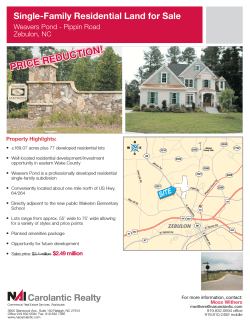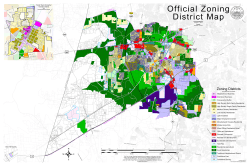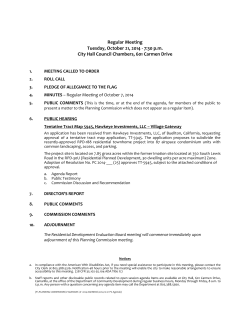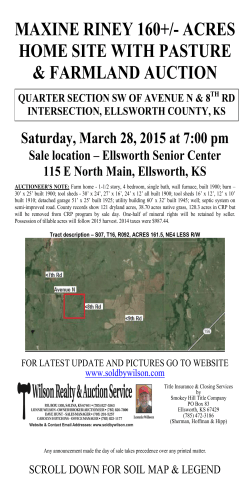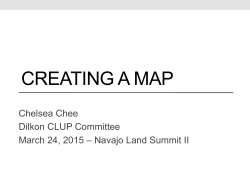
Gallia County Land Use Plan
Gallia County Land Use Plan Dated 1972 1 TABLE OF CONTENTS INTRODUCTION 3 GOALS AND OBJECTIVES 3 RESIDENTIAL 4 COMMERCIAL 6 INDUSTRIAL 8 PUBLIC AND SEMI-PUBLIC 10 AGRICULTURE 10 2 Land Use Plan (1972) Introduction The land use plan is another essential element of the comprehensive plan. Without a thorough understanding of existing land uses and projected needs, an area would suffer in the competition to attract new residents, businesses and industry. This plan can further designate the relationship of major growth areas like Gallipolis, Green Township and Rio Grande to the outlying areas. It can define the areas and standards for new subdivisions. With the advent of new areas of growth will be the related expansion of amenities-schools, parks, water and sewer lines, street lighting and so on. Most importantly, the land use plan can be referred to for guidance by all those who are investing their time and capital in the future of Gallia County. The Land Use Plan is recognized as a proposal for the future use and the structures placed upon the land. It is developed, based upon past and present uses as well as principles and assumptions for arriving at a future land use. It is generalized but presents a scheme for the future development of the urban and rural area. It contains proposals for residential, commercial, industrial, and public lands and shows the relationship of the existing uses to the future. These land use classifications must be considered by Gallia County when undertaking a zoning resolution for the County since the proper classification is essential to the workable zoning document. Zoning is one of the legal devices for implementing the proposals of land development as set forth and designated in the land use plan. It is more exacting in detail and establishes districts where uses may exist. It establishes the general criteria of how these uses will relate one to the other. Therefore, the zoning ordinance is a prerequisite in achieving the objectives of the land use plan. Goals and Objectives To be effective, each element of the land use plan must have certain objectives in its formation. However, general objectives can fit the fruition of a land use plan. The Gallia County Planning Commission has wisely adopted a set of guidelines to prepare the County in undertaking its development for the near future (1-5 years) and the more distant future (5-20 years). Although not all of these objectives are covered within the first year study, it seems appropriate to reiterate them at the beginning phase of the projected studies. • • • Based on population and economic forecasts and trends in population and employment distribution and location, total future land use policies and requirements will be determined. Basic policies concerning the amount and intensity of each land use category will be established. Based on the analysis of the existing land use patterns, the physical attributes of vacant land, land use requirements and policies, and planning principles, the future general pattern will be developed. 3 • • • • Alternative future land use patterns should be analyzed and their implications examined in preparation for the development of the land use plans. The unified land use development of watersheds should receive emphasis including conservation measures, floodplain development and recreation. Possible water impoundment sites will be identified where feasible. Specific areas with an identified industrial potential shall be located and their implications with respect to the overall plan will be examined. Environmental Assessment - Upon summarization of the above plans, an environmental assessment should be made that will cover the following evaluation: (1) Probable environmental consequence of the plan or recommendations; (2) Probable adverse environmental effects which cannot be avoided; (3) Alternatives, if any; and (4) Irreversible commitments and longterm consequences. Residential General policies guiding residential growth should include: • • • • • Residential growth should incorporate the "suitability-capability approach to planning." That is, development factors such as soil suitability, slopes, bedrock and natural drainage courses must be considered when introducing new land subdivisions. Through zoning and other development control devices, incompatible land uses such as warehousing, mining, and manufacturing should be adequately buffered and screened from residential land uses. Existing neighborhoods should be upgraded whenever possible by the provision of adequate community facilities and public utilities. Density controls should be adopted and enforced to protect the environment and to avoid overtaxing public services. Growth should be encouraged to take place around existing growth areas (e.g. Gallipolis, Rio Grande) where existing facilities such as water and sewer and fire protection can be extended. There presently exists 11,140 acres of residential land in Gallia County representing less than 4 percent of the total acreage. Dominant areas of residential land use include the City of Gallipolis, 702 acres; Green Township, 1,758 acres; Springfield Township, 1,211 acres; and Addison Township, 1,011 acres. Residential uses are expressed in terms of density; that is, the number of housing units per acre. This term only defines development objectives and should not be interpreted to define housing types. Based on the population projections of an additional 6,500 persons in the County within the next twenty years, approximately 2,785 acres of residential land use will be needed to accommodate the increase. Because of this increase, about 2,114 new housing units will be needed. Due to the substandard condition of many existing housing units, about 1,180 units should be replaced. It is proposed that these new housing units be distributed to the following densities: • • Low Density (one per acre) Medium Density (two to four per acre) 4 • High Density (five to sixteen per acre) Housing is not as restricted to level ground as certain industrial and commercial uses. The specific areas of future residential growth are indicated on the Land Use Map. New subdivisions may include mobile home parks and planned unit development (PUD). The PUD concept includes not only various residential densities but supporting uses as well. There are other items for consideration in proposing future residential land uses. Traffic congestion and through streets should be minimized. Major roads should be placed at the periphery and natural features such as creeks, rivers, or hills should be utilized as boundaries. Many of the young married couples and retired persons prefer apartment living to the maintenance of a home. Gallipolis and Rio Grande are prime areas for multi-family development because of the existing populace in the City and the College in Rio Grande. In addition to an existing populace, some of the other factors that relate to multi-family developments are the extensions of utilities, both water and sewer and land that is not restrictive in elevation and drainage. The proximity to employment areas contributes largely to increased densities in residential development also. According to the land use plan, two types of residential growth are projected. There are corridor and cluster developments. Due to the extensions of a rural water system, which endorses lineal or corridor growth, a continuation of this residential pattern will exist in Gallia County. The initial systems of rural water expansion have allowed for a 100 percent increase in users along its corridor extension. Only where line sizes are adequate will this utility service provide for clustering of residential developments. It is expected from topographical limitations that corridor growth will continue along State Routes 7, 141, 588, 160 and along US Route 35. This corridor development has already hampered thoroughfare movements emanating from the Gallipolis City corporation. Provision should be made for future corridor growth to provide for marginal access roads limiting the ingress and egress of traffic movements. These marginal access roads would solve many of the problems relating to connection and road cuts along the existing arterial network. It is projected that the primary residential growth will occur in six areas. Four of these areas are extensions of growth from existing communities. Before the growth is realized, public utilities must be offered or improved. Presently, only Rio Grande and Gallipolis contain both water and sewage capabilities. These communities will provide for continued residential expansion. It is projected that the densities will increase in the corporation of Gallipolis to fill in the large amounts of vacant area existing. Rio Grande is expected to grow to the north and west of the existing residential development. This growth will be related primarily to the new vocational school and Rio Grande College located in the community. The Villages of Cheshire and Vinton are seen to contain additional residential capabilities. Cheshire has available land to the north and west of the present corporation. With the close proximity to the Ohio Power Plant, this area is designated for residential 5 growth. Vinton has utility capabilities only in the area of water service. With its proximity to the Meigs Mines, it is believed that the residential growth will continue to fill in the vacant areas in the incorporation. The remaining two residential locations are designated because of the past growth trend in the County. The area west of the intersection of State Route 160 and US 35 is a primary residential growth area for the future of Gallia County. This area has already received large-scale subdivision activity. Utility service is provided by a combination of the rural water system and the extension of the City of Gallipolis Sewage System. These amenities, along with a satisfactory topographic elevation, provide for increased residential utilization. The remaining area of residential growth is scheduled in Clay Township, along the Ohio River, on State Route 7. Although the area is restricted in utility requirements, seasonal home use and topography enhance its development potential. It is expected that rural water will be supplied upon increased densities of development. Sewage capabilities must be handled on an individual package plat basis. Although many persons are willing to drive a long distance to work (many County residents commute to jobs outside County lines), residential areas, whenever possible, should be located within a few minutes driving time of commercial and industrial sites. Because of the potential for recreation in the County and the existence of miles of riverfront, seasonal homes should be considered as a potential building stimulus to the area. Other areas of cluster development are indicated on Plate 12, Development Factors. This includes an extension of the Rio Grande growth area and a new cluster development potential around the Bidwell-Porter vicinity. Again, the topography and future provision of utility extensions will make these areas suitable for residential expansion. Commercial As pointed out in previous studies, Gallipolis is an important retail trade center in the County. Selected services continue to grow although marked by a glaring lack of recreational and cultural activities. The future commercial development in the County will include a strong continuation of the Central Business District of Gallipolis along with expansion of outlying shopping centers. Supportive commercial activities will sprout up along the major arterials. Neighborhood-type shopping areas should be introduced in the smaller clusters of population growth such as Vinton, Rio Grande, Crown City and Cheshire. More than likely, commercial activity near Salem Center (mining site in Meigs County) will attract residents from the County, particularly in the eastern sections. By 1990, population growth will command an increase in commercial acreage to 660 acres, an increase of 132 acres. Most of this will continue to go into retail trade and selected services with approximately 10-15 percent going to wholesale trade. Certain standards can guide the County in its future commercial development. Two general categories will be discussed, a neighborhood center and a community shopping district. 6 A neighborhood center specializes in the sale of convenience goods and personal services. Establishments in such a center include a food store or pharmacy. They are generally located at the intersection of primary streets or secondary roads, serve an area up to one half mile, and support a population of 2-4,000. The site should be 2-5 acres, contain 15-25,000 square feet of gross floor area and contain two to four stores. Parking will be determined by the amount of gross floor area (one space to each 200-sq. ft.) plus the number of employees. A community shopping district serves some of the functions of a neighborhood center plus the sale of general merchandise, wearing apparel, furniture, and professional services (doctors, lawyers and bankers). Tenants include one or more small department store and variety shops. These should be located adjacent to major traffic arteries in a central location and serve the entire urban area (10-20,000 persons). Sites should be 8 to 10 acres, contain 10 to 20 stores with 100-200,000 square feet of gross floor area. Parking should again be based on the same premises with each space 200 square feet. Loading docks should be provided out of the main traffic areas and be 250 square feet with 15 feet of clearance height. The increases in retail trade and the related sales force should account for 3,650 jobs in the County over the next twenty years. The recent parking study prepared for the City of Gallipolis should aid, if properly implemented, in the control of downtown parking space and remove points of congestion. New commercial establishments should be located in the larger business districts or grouped along major roads or at crossroads and interchanges. Because retailing is highly competitive, commercial land use will require changes in zoning from time to time. Certain development policies should control future commercial expansion. These include: • Careful consideration must be given before a "ring" of shopping centers is developed around Gallipolis or any other existing commercial center. This can choke off the regional function of the downtown center. • Strip development should be discouraged. This should go hand-in-hand with zoning regulations, which provide adequate amounts of land in logical locations for commercial activity. • If a new location is shown to present problems of access or traffic, then the developers should be encouraged to utilize existing centers. • Consideration should be given to the introduction of open space or recreational areas into business areas such as the City Riverfront Park in Gallipolis. • Vacant commercial institutions should be restored or razed. • Another guideline would be the provision of adequate parking and loading facilities and then separation of pedestrian and vehicular traffic in present and future commercial areas of activity. • Final guideline would be to distribute professional services such as medical, dental, financial, real estate and legal activities around retail centers in approximately the same proportions as retail shopping acreage. To be more specific about proposed commercial locations, it is assumed that the transportation oriented commercial activities will group themselves at the primary intersections of State Route 7 and US 35; at State Route 160 and US 35; and in the cluster development where population densities will support a neighborhood center. These centers 7 will develop most probably in the Planned Unit Development concept of subdivision regulations. These cluster developments are shown on Plate 12, Development Factors. As stated earlier, continued effort should be promoted to expand the commercial facilities and offerings in all the incorporated areas. These areas would not be offering new commercial locations but would be expansions of existing centers. With the exception of the City of Gallipolis, these commercial areas would be designated as neighborhood or community shopping facilities. The City of Gallipolis should make provisions for the expansion of the Central Business District through the zoning capabilities administered in this community by rezoning appropriately designated land for commercial uses. These rezoned areas would be logical expansion areas of the core Central Business District of the City. Additional regional shopping facilities should be discouraged in the incorporated area. Industrial About 15 percent of the labor force are now employed in manufacturing. This will undoubtedly rise as Gallia County continues to become a more industrially based economy. Agriculture continues to lose its once prominent position in the county's economy and industry, the crafts, and retail trades draw from the once dominant farm labor force. At the present time, slightly over 700 acres (721) or approximately 2.0 percent of the developed land is used for industrial purposes. Most of the existing industries are situated in Gallipolis with only a few in the remaining villages and townships. (Note: Springfield Township actually lists the most industrial acreage according to the County Auditor, 416 acres, or 57 percent of the total.) Major employers in the County now include those manufacturing engines, processing meats, producing upholstered furniture, and fabricating metal products. By 1990, approximately 900-1,000 acres will be industrially classified. In a previous study completed for the Chamber of Commerce, certain areas were designated for industrial expansion. The areas chose in the Chamber report include the following areas and are presented in the order of there potential: • • • • The Gallipolis Industrial Park Site which is partially developed and rates the highest of the nine industrial park sites based on transportation access, availability of utilities, soils, topography, site size, flooding and compatibility with surrounding land uses and planning and zoning. This site ranks high since it is an established industrial park under ownership of a development organization with industrial zoning. The Rodney Area (two large areas adjacent to US 35; one to the northeast of Rodney and one to the southwest of Rodney). The areas do have the size, both being over 250 acres, access, topography, and no history of flooding. The main deterrent is lack of sewage disposal facilities. The Cheshire Area (large area on Ohio River's west bank; north of Kyger Creek Power Plant and north and south of Cheshire). The main deterrents to these areas are lack of central sewage and ownership. If the land is owned or planned to be purchased by the power plant, then industrial usage will be limited. In its favor, the area has a main line rail access to the Ohio River and large quantities of underground water. The Bidwell Heights site (500 acres south of Bidwell between the Bidwell-Rodney Road and State Route 554). The site's assets include a large amount of acreage, 8 • • a mainline rail running through the site and no flooding. It is however, in a rather poor location, lacks central sewage and water with poor underground water supply. The Swan Creek Area (500-acre site on the West Bank of the Ohio River in the southeastern portion of the county). The site is isolated but has large quantities of underground water, access to the Ohio River, and no serious flooding problems. There is no natural gas on site or nearby. The site is recommended for a large river oriented industry. The Porter Site (50 acres directly west of Porter on the north side of State Route 554 across from the Bidwell-Porter School). The site is small and lacks adequate water supply and sewage disposal. As pointed out, this phase of the economy is expected to rapidly grow over the next tow decades and a wide choice of sites is advantageous for proper selection. Industrial land uses are most seriously limited to level land. In most cases some of the standards include limiting large industries to grades of less than 8 percent. Rail access is limited by grades of 3 percent or less. In addition, flooding can be an adverse development factor in the location of manufacturing establishments. At one time, the dominant thinking was to allocate the least desirable sites to industry. This thinking has progressively changed and the importance of good industrial sites is well known and encouraged. Prevailing winds should be considered if the plant generates any noticeable air and noise pollutants. One acre of open space should be provided for each 100 employees. It is important to remember that a certain amount of arbitrary reasoning goes along with industrial site selection. An industrialist may have certain requirements for specialized labor, access, availability of raw materials that only a few areas can satisfy. More than likely, however, most areas can satisfy or meet the demands of a particular industry seeking a new site. What may determine the final choice are such things as first impressions, community attitudes, or even the personal desires of top management. Industrial policies should include such important items as: • • • • • • A diversification of the industrial base. There are many smaller more sophisticated businesses, which might easily be attracted to a relatively rural area such as Gallia County. Continual education of the work force will produce the required technical skills needed within the County. Zoning regulations should be adopted to provide standards for an industrial park. Deteriorated industries should be replaced to maintain an attractive setting for the existing industrial base. Future industrial parks should be located within easy driving distance of the workers (a new industry naturally generates residential and commercial activity around it), but buffered from nearby residences. Existing and proposed industries should be made attractive with landscaping, plant design, walkways and screened storage areas. A most important concern of any industrial expansion program is to provide adequate expansion room for industry. If possible, available land around existing plants should be offered to the owners and new sites should contain the needed room. This is to prevent the industry from moving out of the county when expected growing pains might be stifled by lack of space. 9 Public and Semi-Public As previously stated in the section on General Land Use Pattern, public land uses are found on non-profit, publicly owner property and semi-public land uses occur on non-profit, privately owned property. Both types may be open to the general public although quasipublic are sometimes more restrictive. In these types of land uses are schools, governmental buildings, hospitals, churches, and highway right-of-ways. Over 7,000 acres (7,072) are classified as public and quasi-public uses in Gallia County (2.4 percent of all acreage). The bulk of this land is in Raccoon Township (1,390 acres); Walnut Township (539 acres); Huntington Township (536 acres); and Green Township (467 acres). These four townships account for over 41 percent of the total usage. In Gallipolis, public and semi-public lands are scattered throughout the City. School, park and church facilities are found near the business area. A golf course is found adjacent to the Gallipolis State Institute. The Village sewage disposal plant is located in the eastern section while a large cemetery and Community Park are located at the City's western end. Future growth in Gallia County should prompt the addition of about 1,770 acres for a total of 8,842 acres. Most of this will go into new school and park sites. Various standards of maximum usage have been discussed in detail in the plans on schools, fire stations, parks and open space. Certain policies should guide the future development of public and semi-public land uses: • • • • • • • • • The general use and appearance of these lands and related activities should set an example for private development. Special studies may be necessary to provide the various public agencies detailed analysis on exact size, site, and extent of public and semi-public facilities. However, whenever possible, the Land Use Plan should be used as a reference guide. As governmental activities increase, so should the need for public building space. This should be considered by the County Commissioners in planning long-range expenditures. Whenever possible, public buildings may serve as a buffer between residential and commercial or other uses. Each public facility should provide its own off-street parking. Semi-public institutions should seek professional advice when selecting new locations or expanding present sites. Space should be provided for public easements; utilities should be placed underground. Drainage and soil suitability must be considered in site selection. Floodplain development, except for a certain amount of open space land, should be avoided for public uses. Advance purchase of vacant lands should be considered for reservations of future public and semi-public needs. Agriculture Farming remains important in the Ohio Valley Development District. About 59 percent of the total land in the District is devoted to agriculture. Agriculture is the District's 10 fourth largest employer and the third largest producer of income. Over $60 million a year comes from the sale of farm products. Much of the ideal farming land is scattered throughout the eleven counties and many acres that have in the past been used for crop production have been converted to pastureland. Naturally, the low-grade farmland may well be suited for residential subdivision, but once higher-grade land is turned over for speculative residential, commercial, or industrial development, it is lost to the farmer for decades. Total developed agricultural lands in Gallia County amount to 161,159 acres. All agricultural lands shown on the Existing Land Use Table which includes forest reserves and undeveloped open lands total 260,606 acres. Between 1960 and 1970, land removed from agriculture amounted to some 38,000 acres. This trend is likely to continue, as there has been a 33 percent decline in the number of farms over the past decade. While the agriculture, forestry, and fisheries industry accounted for only 7 percent of the employed labor force in 1970, this represents a drop of 10 percent from 1960. It is assumed that the land needed for other land uses; that is, residential, commercial, industrial, public and semi-public will be extracted from the existing agricultural lands. This would only mean a reduction in agricultural reserves of about 5-8,000 acres, which would be an insignificant amount. Allowing for the reduction, the County would still contain 153-156,000 acres of developable farmland. The typical farmland in Gallia County, as well as in other rural counties, appears to be in a transitional stage. Constant pressure is being applied to many farmers to sell off part of their prime holdings and enter the urban job market. It becomes increasingly difficult for the farmer to retain land in agricultural use as suburban-type development continues to flow into the rural areas. What is important is that the County adopts certain policy standards in controlling the wasteful loss of prime agricultural land. These may include but are not limited to: • • • • • • • A strong zoning ordinance should be adopted on a countywide basis to protect agricultural districts and limit the types of allowable uses within that established zone. Although it is important that certain community facilities and utilities be provided before residential development, it is not necessary prior to agricultural usage. Taxation for farmland production should be assessed on a pro-rated basis dependent upon the amount of actual harvested cropland versus that which is in pasturage. Consideration should be given to at least one agriculture district that would restrict rural non-farms. In agriculture conservation districts, only those land use groups should be permitted which are functionally related to conservation districts. If possible, agriculture oriented trades and services (feed mills, farm cooperatives, farm equipment sales and repair) should be accommodated in rural trade centers. The farming sector of the county should be encouraged to participate in the comprehensive planning process. 11 Although the Land Use Plan designates areas for future use of residential, commercial, industrial, public and agriculture, it should be remembered that other factors influence development potential. These factors have been considered and are presented on Plate 12. Plate 4 presents the location of these uses in Gallia County. It presents not only those uses that are existing but also extensions of those that are foreseen in the next twenty years. Each land use should receive prioritizing for development. In other words, the industrial sites represent those areas available for industrial expansion but are not necessarily prioritized in order of importance or need. Also, prime agricultural land should warrant consideration for preservation. It should be reserved from urban expansion. 12
© Copyright 2026
